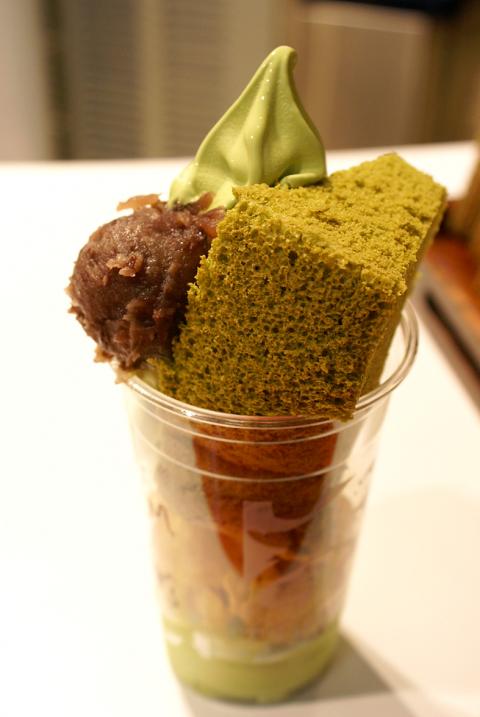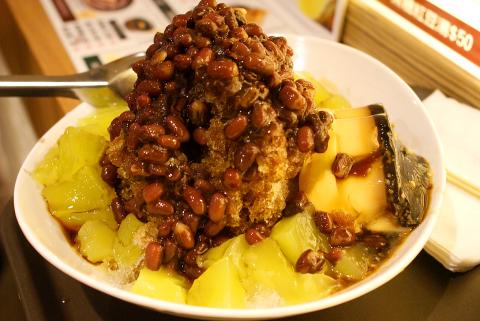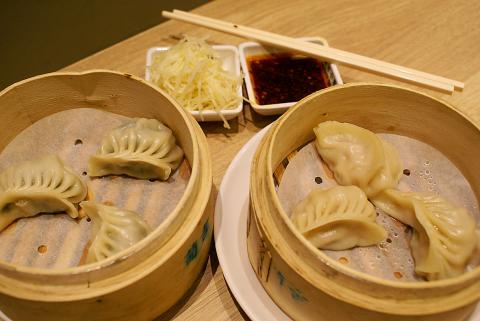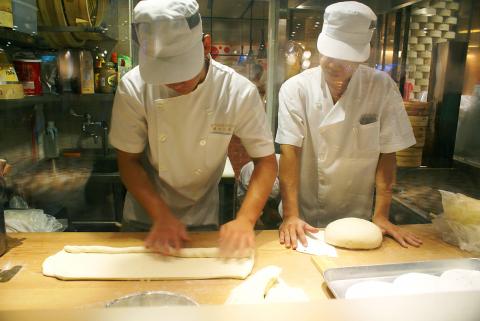Does Taipei really need another luxury department store? This was my first thought when my editor asked for a review of the food court in the basement of the recently opened Uni-President Hankyu Department Store (統一阪急百貨), located next to the Taipei City Hall MRT Station (市政府捷運站).
With Shin Kong Mitsukoshi (新光三越), Breeze Center (微風廣場), Sogo (太平洋崇光百貨) and Living Mall (京華城) — to name some of the luxury department stores that have opened in the capital’s East District (東區) over the past decade — Taipei’s shopping scene isn’t in want of high-end palaces devoted to consumption. Still, Taiwan’s Uni-President teamed up
with Japan’s Hankyu Hanshin Department Stores to open Hankyu. Will it

Photos: Noah Buchan, Taipei Times
increase consumer desire or create an anti-shopping backlash?
Almost certainly the former. Walking, or jostling, my way into the seven-story store on Thursday at 3pm, a week after it opened on Oct. 7, I scrambled past hordes of shoppers taking advantage of discounts offered until the end of this month. Upon entering the B2 food court area I was faced with a crowd so daunting, I escaped to the relative tranquility of the MRT station.
The multitudes of people hadn’t diminished by the following Monday. “Doesn’t anyone in Taipei have a job?”

Photos: Noah Buchan, Taipei Times
I thought.
I again forced my way through the food court, which plays heavily on Japanese and Taiwanese culinary themes.
The center of the L-shaped space features dessert shops — including Mister Donut, Mydori and the popular Japanese chain store Tsujiri — that share space with Taiwanese shops selling traditional snacks.

Photos: Noah Buchan, Taipei Times
On one end is an open-space dining court, where patrons linger in front of large tables after ordering from any of the 10 stalls that sell the kind of street food — fried rice noodles, shaved ice and luwei (滷味) — popular at night markets.
Surrounding the food court are sit-down restaurants that entice diners with plastic food displays in their windows. Ichi Ichi, Azabu Sabo, Tokyo Curry Espresso and Kegatsu, which all serve Japanese-style curry, shabu shabu, sukiyaki and noodles — were packed, as was Hi Sushi. Not wanting to wait in line, I settled on Kitchen Pucci, a Shanghai-style restaurant that was partially empty.
Visitors lined up to take pictures of the chefs at Kitchen Pucci. The interior is tastefully decorated with hanging ceiling lamps made from large bamboo steamers.

Photos: Noah Buchan, Taipei Times
Kitchen Pucci serves its dumplings dim sum style, which means they come in portions of three or six, rather than the standard 10, enabling diners to experiment with the nine different varieties. I went with three: steamed dumplings with pork (NT$120 for six, NT$50 for three), shrimp (NT$120 for six, NT$60 for three) and leek (NT$80 for six, NT$40 for three). Each order was served in its own mini-bamboo steamer with generous portions of fresh ginger.
Though the dumplings didn’t stand out from those at similar Taipei restaurants, the fried rice with pork and egg (NT$120) did. Generous strips of largely gristle-free pork were mixed in with leek, egg and long-grain white rice. With its minimal use of oil and strong flavor, it is among the best I’ve tried in Taipei. The
wontons in chili oil (NT$100) were
poorly presented, but the spicy flavor didn’t suffer as a result.
An hour later I mustered the patience to stand in line at Tsujiri. The dessert stand serves up parfaits, sundaes, floats and hot and cold drinks — all with a green tea twist. The line was long, but the 25-minute wait was still much shorter than the two-hour ordeal people put themselves through when Taiwan’s first Mister Donut opened in 2004.
The chiffon cake and soft ice cream parfait (NT$170), topped with a scoop of mashed red bean, was a triumph of taste and texture. The soft ice cream mixed nicely with the mashed potato texture of the beans and the spongelike cake, while the sweetness of the ice cream and slight bitterness of the green tea were a surprisingly tasty combination. After a few bites the long lines didn’t seem so insane.
Those hankering for Japanese-themed food or high-quality Taiwanese street snacks should try out Hankyu’s food court. You might, however, want to wait a month or two for the crowds to die down.

April 28 to May 4 During the Japanese colonial era, a city’s “first” high school typically served Japanese students, while Taiwanese attended the “second” high school. Only in Taichung was this reversed. That’s because when Taichung First High School opened its doors on May 1, 1915 to serve Taiwanese students who were previously barred from secondary education, it was the only high school in town. Former principal Hideo Azukisawa threatened to quit when the government in 1922 attempted to transfer the “first” designation to a new local high school for Japanese students, leading to this unusual situation. Prior to the Taichung First

When the South Vietnamese capital of Saigon fell to the North Vietnamese forces 50 years ago this week, it prompted a mass exodus of some 2 million people — hundreds of thousands fleeing perilously on small boats across open water to escape the communist regime. Many ultimately settled in Southern California’s Orange County in an area now known as “Little Saigon,” not far from Marine Corps Base Camp Pendleton, where the first refugees were airlifted upon reaching the US. The diaspora now also has significant populations in Virginia, Texas and Washington state, as well as in countries including France and Australia.

On April 17, Chinese Nationalist Party (KMT) Chairman Eric Chu (朱立倫) launched a bold campaign to revive and revitalize the KMT base by calling for an impromptu rally at the Taipei prosecutor’s offices to protest recent arrests of KMT recall campaigners over allegations of forgery and fraud involving signatures of dead voters. The protest had no time to apply for permits and was illegal, but that played into the sense of opposition grievance at alleged weaponization of the judiciary by the Democratic Progressive Party (DPP) to “annihilate” the opposition parties. Blamed for faltering recall campaigns and faced with a KMT chair

Article 2 of the Additional Articles of the Constitution of the Republic of China (中華民國憲法增修條文) stipulates that upon a vote of no confidence in the premier, the president can dissolve the legislature within 10 days. If the legislature is dissolved, a new legislative election must be held within 60 days, and the legislators’ terms will then be reckoned from that election. Two weeks ago Taipei Mayor Chiang Wan-an (蔣萬安) of the Chinese Nationalist Party (KMT) proposed that the legislature hold a vote of no confidence in the premier and dare the president to dissolve the legislature. The legislature is currently controlled